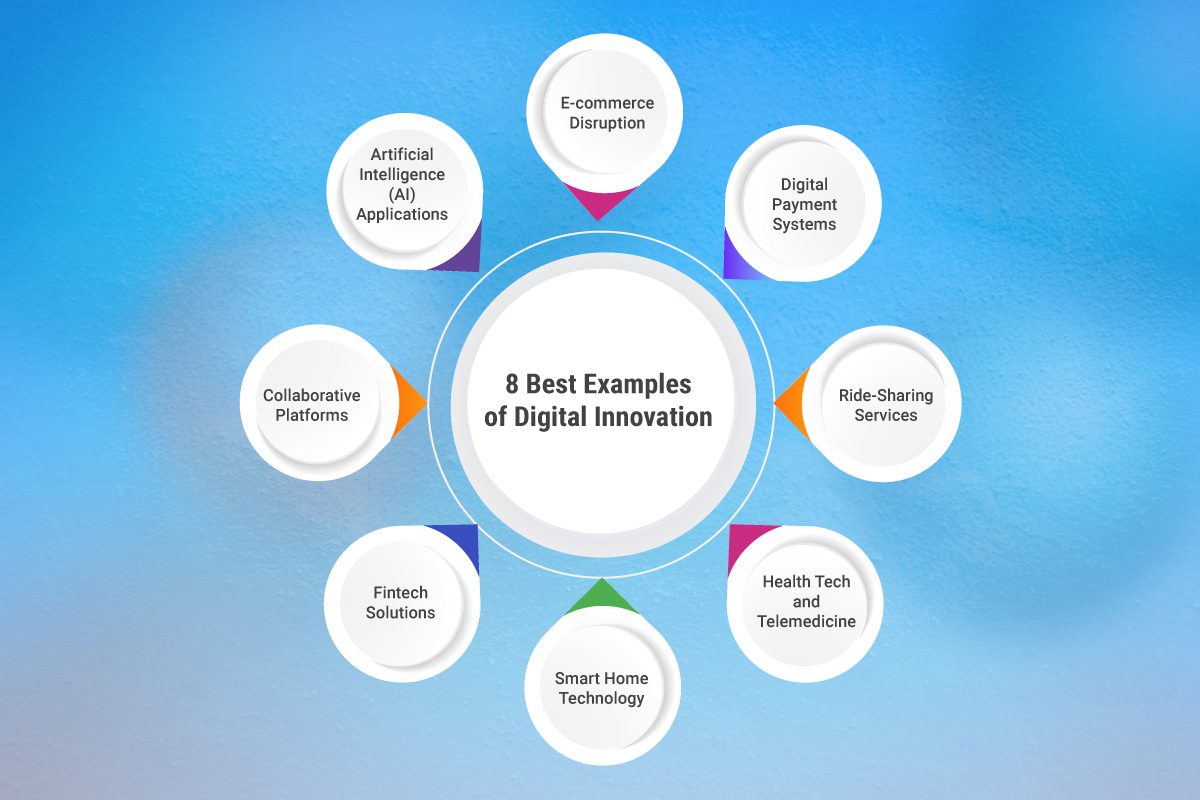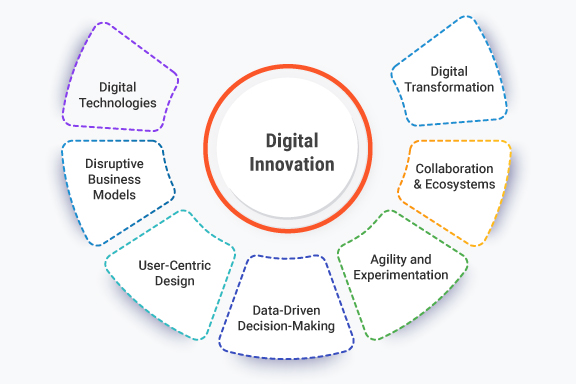What is Digital Innovation?
Digital innovation is defined as the process of utilization of digital technologies and strategies to create new or improved products, services, processes, and business models. It involves leveraging digital tools and platforms to drive transformation, enhance customer experiences, and generate value.
Here are some key reasons why digital innovation is so important today:
- Competitive Advantage: Digital innovation enables businesses to gain a competitive edge in the marketplace. By leveraging digital technologies and strategies, organizations can differentiate themselves from competitors, deliver unique value propositions, and capture new market opportunities. It allows companies to stay ahead of the curve and adapt to changing customer preferences, emerging trends, and disruptive market forces.
- Enhanced Customer Experience (CX): Digital innovation focuses on improving customer experience and interaction. By leveraging digital channels, personalized marketing strategies, intuitive user interfaces, and data-driven insights, organizations can deliver tailored and seamless experiences to their customers. This leads to higher customer satisfaction, increased loyalty, and a positive brand reputation.
- Increased Efficiency and Productivity: Digital innovation helps optimize business processes and streamline operations. By automating manual tasks, integrating systems, and leveraging data analytics, organizations can enhance efficiency, reduce costs, and improve productivity. Digital tools such as workflow management systems, robotic process automation, and cloud computing enable streamlined operations and faster decision-making.
- New Revenue Streams: Digital innovation opens up new avenues for revenue generation. By leveraging digital technologies, businesses can create innovative business models, products, and services that tap into previously untapped markets. For example, the rise of the sharing economy, subscription-based services, and digital platforms has created new revenue streams and disrupted traditional industries.
- Data-Driven Insights: Digital innovation relies heavily on data collection, analysis, and interpretation. By harnessing big data analytics, machine learning algorithms, and predictive modeling, organizations can gain valuable insights into customer behavior, market trends, and business performance. Data-driven insights enable informed decision-making, targeted marketing, and proactive innovation strategies.
- Agility and Adaptability: Digital innovation fosters an agile and adaptive organizational culture. It encourages experimentation, continuous learning, and the ability to quickly respond to changing market dynamics. Organizations that embrace digital innovation are better equipped to navigate uncertainties, seize opportunities, and adapt their strategies in a rapidly evolving business environment.
Overall, digital innovation is crucial for organizations to thrive in the digital age. It empowers businesses to be more competitive, customer-centric, efficient, and adaptable, thereby enabling sustainable growth and long-term success.
The key components of digital innovation include:
- Digital Technologies: Digital innovation relies on the use of various digital technologies such as artificial intelligence (AI), machine learning, data analytics, cloud computing, the Internet of Things (IoT), blockchain, and virtual/augmented reality (VR/AR). These technologies serve as the building blocks for creating innovative solutions and transforming innovation processes.
- Disruptive Business Models: Digital innovation often involves the development of disruptive business models that challenge traditional industry practices. Examples include platform-based businesses like Uber and Airbnb, subscription-based services like Netflix, or direct-to-consumer e-commerce models. These business model innovations leverage digital platforms, data-driven insights, and user-centric approaches to deliver value in novel ways.
- User-Centric Design: Digital innovation places a strong emphasis on understanding user needs and preferences. User-centric design methodologies, such as design thinking and user experience (UX) design, are employed to create intuitive and engaging digital experiences. By prioritizing customer feedback and iteratively refining solutions, digital innovators can develop products and services that meet customer expectations.
- Data-Driven Decision-Making: Data plays a critical role in digital innovation. Organizations collect and analyze vast amounts of data to gain insights into customer behavior, market trends, and operational efficiency. Data-driven decision-making enables organizations to make informed choices, identify opportunities, and optimize their digital strategies.
- Agility and Experimentation: Digital innovation thrives on an agile mindset and a willingness to experiment and iterate. It involves adopting iterative development methodologies, such as Agile or DevOps, to quickly respond to changing market demands. Organizations that embrace a culture of innovation can test new ideas, learn from failures, and adapt their strategies accordingly.
- Collaboration and Ecosystems: Digital innovation often involves collaboration within ecosystems of partners, suppliers, and customers. Open innovation approaches, such as co-creation and partnerships, enable organizations to leverage external expertise, access complementary resources, and foster innovation through collective intelligence.
- Digital Transformation: Digital innovation is closely tied to digital transformation, which refers to the comprehensive integration of digital technologies and strategies across an entire organization. It involves rethinking processes, organizational structures, and business models to embrace the full potential of digital capabilities.
By embracing these key components, organizations can harness the power of digital innovation to drive growth, enhance competitiveness, and deliver value to customers in the digital age.
Learn more: What is Innovation?
8 Best Examples of Digital Innovation

There are numerous examples of digital innovation across various industries. Here are a few notable examples:
1. Smart Home Technology
The Internet of Things (IoT) has fueled digital innovation in the realm of smart homes. Devices such as smart thermostats, voice-activated assistants (e.g., Amazon Echo, Google Home), and connected home security systems allow homeowners to control and automate various aspects of their homes remotely. These innovations enhance convenience, energy efficiency, and security.
2. E-commerce Disruption
Companies like Amazon and Alibaba have revolutionized the retail industry through digital innovation. They pioneered the concept of online marketplaces and transformed the way people shop by providing a convenient and personalized online shopping experience. Their use of advanced logistics, recommendation systems, and secure payment gateways has reshaped the retail landscape.
3. Digital Payment Systems
Digital innovation has transformed the way we make payments. Services like PayPal, Apple Pay, Google Pay, and cryptocurrencies such as Bitcoin have revolutionized traditional payment methods. These digital payment systems offer speed, convenience, security, and global accessibility, making transactions more seamless and efficient.
4. Fintech Solutions
Financial technology (fintech) has disrupted traditional banking and financial services. Companies like Square, Stripe, and Robinhood provide innovative digital solutions for payment processing, online banking, investing, and personal finance management. These platforms leverage technological innovation to offer faster, more accessible, and user-friendly financial services.
5. Ride-Sharing Services
Companies like Uber and Lyft have disrupted the transportation industry through digital innovation. Their mobile apps connect riders with drivers, making it easy to book and pay for rides. By leveraging GPS technology and data analytics, these platforms optimize route planning, pricing, and driver allocation, providing an alternative to traditional taxi services.
6. Artificial Intelligence (AI) Applications
AI has driven significant digital innovation across various domains. Chatbots and virtual assistants, such as Apple’s Siri and Google Assistant, provide personalized assistance and enhance customer experiences. AI-powered recommendation systems, like those used by streaming platforms such as Netflix and Spotify, analyze user behavior to provide personalized content suggestions.
7. Health Tech and Telemedicine
Digital innovation has revolutionized healthcare delivery. Telemedicine platforms like Teladoc and Doctor on Demand enable patients to access remote consultations and medical advice from healthcare professionals using video calls. Additionally, wearable devices, mobile health apps, and remote monitoring systems have empowered individuals to track their health, monitor vital signs, and manage chronic conditions more effectively.
8. Collaborative Platforms
Digital innovation has given rise to collaborative platforms that connect individuals, businesses, and communities. For example, Airbnb enables homeowners to rent out their properties to travelers, disrupting the hospitality industry. Similarly, platforms like Upwork and Freelancer connect freelancers with clients, revolutionizing the way people work and find employment opportunities.
These examples illustrate how digital innovation has transformed industries and reshaped the way we live, work, and interact. They demonstrate the power of leveraging digital technologies and strategies to create business model innovation, improve customer experiences, and drive value in diverse sectors.
Learn more: What is Product Innovation?
Top 10 Best Practices for Digital Innovation Strategy
Developing an effective digital innovation strategy requires careful planning and execution. Here are some best practices to consider when formulating and implementing a digital innovation strategy:
- Align with Core Business Objectives: Ensure that your digital innovation strategy aligns with your organization’s core business objectives and long-term vision. Identify how digital innovation can support key business goals, such as increasing revenue, improving operational efficiency, enhancing customer experience, or entering new markets.
- Foster a Culture of Innovation: Create an organizational culture of innovation that encourages and supports innovation. Foster an environment where employees feel empowered to suggest and experiment with new ideas. Encourage cross-functional collaboration and knowledge sharing to foster a culture of creativity and innovation.
- Embrace Agile Methodologies: Adopt agile methodologies and iterative development processes to foster flexibility and adaptability. Break down digital innovation projects into smaller, manageable phases, allowing for rapid testing, learning, and adjustments. Embrace a fail-fast mentality that encourages experimentation and learning from failures.
- Emphasize User Experience (UX) Design: Prioritize user experience in your digital innovation efforts. Invest in UX design methodologies to ensure that your digital solutions are intuitive, user-friendly, and deliver a seamless experience across different devices and touchpoints. Continuously gather user feedback and iterate your solutions based on user insights.
- Customer-Centric Approach: Put the customer at the center of your innovation strategy. Gain a deep understanding of their needs, pain points, and expectations. Use customer feedback and insights to guide your digital innovation initiatives, ensuring that your solutions address real customer challenges and deliver value.
- Leverage Data and Analytics: Harness the power of data and analytics to drive digital innovation. Collect and analyze relevant data to gain insights into customer behavior, market trends, and operational performance. Use data-driven insights to make informed decisions, identify opportunities, and optimize your digital innovation initiatives.
- Foster Partnerships and Collaboration: Collaborate with external partners, startups, universities, and industry experts to leverage their expertise, access new technologies, and co-create innovative solutions. Partnering with external stakeholders can bring fresh perspectives, accelerate innovation, and help overcome resource limitations.
- Encourage Experimentation: Encourage a culture of experimentation and risk-taking. Allocate resources for pilot projects and proofs of concept to test ideation and technologies. Celebrate and learn from both successful and unsuccessful experiments, fostering a culture of innovation and continuous learning.
- Invest in Talent and Skills: Ensure you have the right talent and skills within your organization to drive digital innovation. Invest in training programs, workshops, and certifications to enhance digital literacy and foster a culture of continuous learning. Consider hiring individuals with diverse backgrounds and skill sets to bring fresh perspectives to your digital innovation initiatives.
- Continuous Evaluation and Improvement: Regularly evaluate the impact and effectiveness of your digital innovation initiatives. Use key performance indicators (KPIs) and metrics to measure success and identify areas for improvement. Continuously iterate and refine your digital innovation strategy based on feedback, market changes, and evolving customer needs.
By following these best practices, organizations can develop and implement a robust digital innovation strategy that drives growth, enhances competitiveness, and delivers value in the digital era.
Learn more: What is Business Innovation?
Most Recent Blogs
Explore the latest innovation insights and trends with our recent blog posts.










